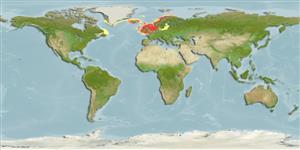Actinopterygii (ray-finned fishes) >
Perciformes (Perch-likes) >
Stichaeidae (Pricklebacks) > Chirolophinae
Etymology: Chirolophis: Greek, cheir = hand + Greek, lophos = crest (Ref. 45335).
Environment / Climate / Range
Ecology
Marine; benthopelagic; depth range 10 - 400 m (Ref. 58426), usually 10 - 30 m (Ref. 35388). Temperate, preferred ?; 72°N - 49°N, 70°W - 32°E
Northeast Atlantic: Norwegian coast to Finmarken and Waranger Fjord, occasionally Murman coast, rare in Skagerrak, Kattegat and Öresund, around Helgoland, also British Isles; also the Orkneys, Faroes, Shetlands and Iceland (Ref. 4782). Northwest Atlantic: Canada (Ref. 7251).
Size / Weight / Age
Maturity: Lm ? range ? - ? cm
Max length : 25.0 cm SL male/unsexed; (Ref. 4782); 18.0 cm TL (female); common length : 17.5 cm SL male/unsexed; (Ref. 4782)
Dorsal
spines
(total): 50 - 54;
Dorsal
soft rays
(total): 0;
Anal
soft rays: 35 - 40. Snout blunt; mouth frog-like. With a large fringed tentacle above each eye, a smaller one in front and others on top of head and on the anterior dorsal fin spines. First anal fin ray a short flexible spine. Lateral line represented by a dorsal and a mediolateral branch of neuromasts (the former begins as a short canal, with 4-5 pores.
Usually over rocks and among seaweeds, never in intertidal zone, at 20 m, but descends from 100-280 m (Ref. 4782). Benthic (Ref. 58426). Feeds on bottom invertebrates (small mollusks, polychaetes, hydroids, sponges), also algae (Ref. 4782). Spawns in October - December (Ref. 35388).
Life cycle and mating behavior
Maturity | Reproduction | Spawning | Eggs | Fecundity | Larvae
Makushok, V.M., 1986. Stichaeidae. p. 1122-1123. In P.J.P. Whitehead, M.-L. Bauchot, J.-C. Hureau, J. Nielsen and E. Tortonese (eds.) Fishes of the North-eastern Atlantic and the Mediterranean. UNESCO, Paris. Vol. 3. (Ref. 4782)
IUCN Red List Status (Ref. 115185)
CITES (Ref. 94142)
Not Evaluated
Threat to humans
Harmless
Human uses
Fisheries: of no interest
More information
ReferencesAquacultureAquaculture profileStrainsGeneticsAllele frequenciesHeritabilityDiseasesProcessingMass conversion
Tools
Special reports
Download XML
Internet sources
Estimates of some properties based on models
Phylogenetic diversity index (Ref.
82805): PD
50 = 0.5039 [Uniqueness, from 0.5 = low to 2.0 = high].
Bayesian length-weight: a=0.00389 (0.00180 - 0.00842), b=3.12 (2.94 - 3.30), in cm Total Length, based on all LWR estimates for this body shape (Ref.
93245).
Trophic Level (Ref.
69278): 3.2 ±0.36 se; Based on food items.
Resilience (Ref.
69278): Medium, minimum population doubling time 1.4 - 4.4 years (Preliminary K or Fecundity.).
Vulnerability (Ref.
59153): Moderate to high vulnerability (46 of 100) .
